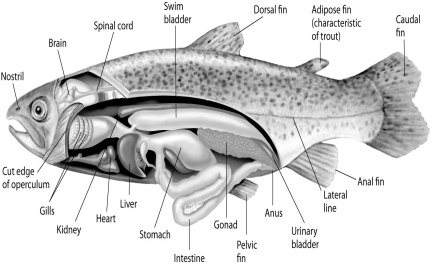
Figure 34.1
Fishes that have swim bladders can regulate their density and, thus, their buoyancy. There are two types of swim bladder: physostomus and physoclistus. The ancestral version is the physostomus version, in which the swim bladder is connected to the esophagus via a short tube (Figure 34.1) . The fish fills this version by swimming to the surface, taking gulps of air, and directing them into the swim bladder. Air is removed from this version by "belching." The physoclistus version is more derived, and has lost its connection to the esophagus. Instead, gas enters and leaves the swim bladder via special circulatory mechanisms within the wall of the swim bladder.
-The presence of a swim bladder allows the typical ray-finned fish to stop swimming and still
A) effectively circulate its blood.
B) be highly maneuverable.
C) use its lateral line system.
D) use its swim bladder as a respiratory organ.
E) not sink.
Correct Answer:
Verified
Q39: Why is the discovery of the fossil
Q40: Among extant vertebrates, a sheet of muscle
Q41: Which of these species was apparently the
Q42: Which of these species was the first
Q43: Which of the following is the most
Q45: Which of the following is the most
Q46: Which of the following statements is correct
Q47: Which of these species was the first
Q48: With which of the following statements would
Q49: Which of the following is a cluster
Unlock this Answer For Free Now!
View this answer and more for free by performing one of the following actions

Scan the QR code to install the App and get 2 free unlocks

Unlock quizzes for free by uploading documents